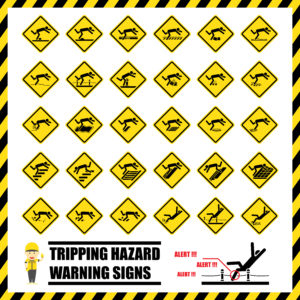Slip-and-fall hazards cause injuries to over a million Americans every year. The CDC reports that 1 out of 5 falls lead to bone fractures and head trauma. Whether it is an elevated fall or an accidental slip on the floor, it often results from negligence.
Not all premises are regularly maintained. Thus, it is important to know about the usual slip and fall hazards that often cause accidents:
1. Wet Floors and Stairs are the Usual Slip and Fall Hazards
Wet floors are always a slip-and-fall hazard. If you have slipped on a washed or soaped surface, then you have an issue with the one in charge of cleaning. Similarly, spilled fluids have the same effect. This is why many slip accidents happen in grocery stores due to the large presence of bottled liquids.
On the other hand, natural weather conditions such as rain and snow also make walkways a slip and fall hazard.
2. Overly Polished Surfaces
According to the National Floor Safety Institute (NFSI), about 7% of slip and fall accidents are caused by the improper use of cleaning products and floor finishes. Wax, polishes, and other cleaning products may cause slippery surfaces. High gloss coatings and finishes usually have a high oil content. As a result, absorption may cause the flooring material to lose traction. Depending on the type of material, the use of chemical products may contaminate the natural texture of stairs and floors. Sure, a shiny floor looks elegant. But when your shoe presses against it, be careful as you may trip due to lack of friction.
3. Poor Lighting
Faulty electric switches and burnt-out bulbs become slip and fall hazards when not replaced as soon as detected. It is the responsibility of the property owner to ensure that there is sufficient lighting in all the walkways throughout the premises. The lighting installations must conform to industry standards. Lights must not be too dim that people could barely see the floors, nor too bright that the floors glare in normal vision.
4. Uneven Walkways are also Slip and Fall Hazards
Sloped surfaces may either be a result of poor construction or a part of the floor design. Problem is, even the slightest change in flooring height may cause people to trip over. Walking surfaces must be consistent. A uniform floor surface will not impede walking momentum.
A good warning sign would be placing reflective tape or grooves on sloped paths so that people would be able to adjust their steps as they walk along.
5. Loose Rugs, Mats, or Carpets
Carpets must be secured or tacked onto the floor and stair surfaces to prevent slip and fall accidents. Mats on entryways must have beveled edges to ensure that they are laid perfectly flat on the floor. Any floor covering with a raised edge can cause trips and slips. Worse, beware of those torn or worn-out rugs with dog-eared, curled corners. Due to poor housekeeping, these become slip and fall hazards. If you trip over a loose carpet, you can hold the owner liable for your injury.
6. Worn-out Floors
Whether it’s made from concrete, vinyl, terrazzo, or ceramic, worn-out flooring material may contribute to slipping accident. Due to foot traffic, the floor traction may be reduced, making the floor slippery as time goes by. Thus, slip and fall accidents can be prevented through regular floor maintenance.
Also, cracks and holes in walkways are slip and fall hazards. These could either be potholes on the parking lot, deep cracks in the concrete pavement, or chipped and broken tiles. With regular maintenance, these could be patched up to prevent accidents.
7. Foreign Debris
Scattered debris like soil, rocks, or anything that is littered on the walkways is always a slip and fall hazard. The one in charge of housekeeping must prevent this from happening by proactively inspecting and removing clutter throughout the premises.
8. Slip and Fall Hazards due to Obstruction
Property owners must remove any obstructions that may cause slip and fall accidents in their walkways. Common obstructions include electrical cords, random floor installations, and decorations across the walking surfaces. In some cases, open cabinet doors, partially closed drawers, and potted plants also become slip and fall hazards.
9. Defective Stairs and Ladders
Like other slip and fall hazards, defective stairs and ladders are a maintenance issue. Those who are responsible for keeping the premises in order should check the condition of their facilities. Stairs without handrails or missing parts of them will inevitably cause fall accidents. Likewise, creaking and broken steps may cause serious and even fatal injuries.
10. Improper Choice of Flooring Material
Among all the slip and fall hazards mentioned above, this is the most expensive to correct. It may be the cause of repetitive slip and fall accidents on a property. For example, while ceramic tile might be a good choice, since it is easy to maintain and inexpensive, it becomes too slippery in damp areas. The same goes for concrete, which must be applied with anti-slip treatments to withstand moisture.
Based on statistics provided by the NFSI, 50% of floor-related accidents are caused by improper flooring materials. Depending on the building’s indoor and outdoor conditions, the flooring and stair materials should be slip-resistant and durable to the level of foot traffic that it will be subjected to.
By identifying these common slip and fall hazards, serious injuries can be prevented. However, if you have been a victim of a slip and fall accident due to the examples mentioned above, then you have the right to seek legal compensation. There are reliable slip-and-fall accident attorneys out there who are ready to help you get the justice you deserve.



